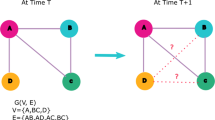Abstract
Link prediction refers to the process of mining and determining whether a link between two nodes in a given network may emerge in the future or it is already present but hidden in the network. Link prediction may be categorized under the class of recommendation systems, e.g., finding or predicting link/recommendation between users and items. Thus, efficient link prediction in social networks is the focus of the study described in this paper. Finding hidden links and extracting missing information in a network will aid in identifying a set of new interactions. We developed a technique for link prediction by exposing the benefits of social network analysis tools and algorithms. We used popular network models commonly used by the research community for testing our algorithm accuracy against well-known algorithms leading to similarity measures. We also decided on using a graph database to model the network for providing better scalability and efficiency compared to storing graph information in a relational database. The experimental results reported in this paper demonstrate how the proposed algorithm outperforms traditional link prediction algorithms described in the literature.
Access this chapter
Tax calculation will be finalised at checkout
Purchases are for personal use only
Similar content being viewed by others
References
Wang J, De Vries AP, Reinders MJT (2006) Unifying user-based and item-based collaborative filtering approaches by similarity fusion. In: Proceedings of the 29th annual international ACM SIGIR conference on research and development in information retrieval. ACM, New York, pp 501–508
Hotho A, Jäschke R, Schmitz C, Stumme G (2006) Information retrieval in folksonomies: search and ranking. Springer, Berlin
Dong L, Li Y, Yin H, Le H, Rui M (2013) The algorithm of link prediction on social network. Math Probl Eng 2013:7 pp.
Heck T, Peters I, Stock WG (2011) Testing collaborative filtering against co-citation analysis and bibliographic coupling for academic author recommendation. In: Proceedings of the 3rd ACM RecSys’ 11 workshop on recommender systems and the social web, pp 16–23
Petry H, Tedesco P, Vieira V, Salgado AC (2008) Icare. a context-sensitive expert recommendation system. In: ECAI’08, pp 53–58
Reichling T, Wulf V (2009) Expert recommender systems in practice: evaluating semi-automatic profile generation. In: Proceedings of the SIGCHI conference on human factors in computing systems. ACM, New York, pp 59–68
Tayebi MA, Ester M, Glässer U, Brantingham PL (2014) Spatially embedded co-offence prediction using supervised learning. In: Proceedings of the 20th ACM SIGKDD international conference on knowledge discovery and data mining. ACM, New York, pp 1789–1798
Benchettara N, Kanawati R, Rouveirol C (2010) Supervised machine learning applied to link prediction in bipartite social networks. In: 2010 international conference on advances in social networks analysis and mining (ASONAM). IEEE, New York, pp 326–330
Hasan MA, Chaoji V, Salem S, Zaki M (2006) Link prediction using supervised learning. In: SDM’06: workshop on link analysis, counter-terrorism and security
Brandão MA, Moro MM, Lopes GR, Oliveira JPM (2013) Using link semantics to recommend collaborations in academic social networks. In: Proceedings of the 22nd international conference on World Wide Web companion. International World Wide Web conferences steering committee, pp 833–840
Chen J, Tang Y, Li J, Mao C, Xiao J (2014) Community-based scholar recommendation modeling in academic social network sites. In: Web information systems engineering–WISE 2013 workshops. Springer, Berlin, pp 325–334
Davis D, Lichtenwalter R, Chawla NV (2011) Multi-relational link prediction in heterogeneous information networks. In: 2011 international conference on advances in social networks analysis and mining (ASONAM). IEEE, New York, pp 281–288
Tang L, Wang X, Liu H (2009) Uncoverning groups via heterogeneous interaction analysis. In Ninth IEEE international conference on data mining, 2009. ICDM’09. IEEE, New York, pp 503–512
Radivojac P, Peng K, Clark WT, Peters BJ, Mohan A, Boyle SM, Mooney SD (2008) An integrated approach to inferring gene–disease associations in humans. Proteins Struct Funct Bioinf 72(3):1030–1037
Heck T (2013) Combining social information for academic networking. In: Proceedings of the 2013 conference on computer supported cooperative work. ACM, New York, pp 1387–1398
Sun Y, Barber R, Gupta M, Aggarwal CC, Han J (2011) Co-author relationship prediction in heterogeneous bibliographic networks. In: 2011 international conference on advances in social networks analysis and mining (ASONAM). IEEE, New York, pp 121–128
Lopes GR, Moro MM, Wives LK, De Oliveira JPM (2010) Collaboration recommendation on academic social networks. In: Advances in conceptual modeling–applications and challenges. Springer, Berlin, pp 190–199
Lichtnwalter R, Chawla NV (2012) Link prediction: fair and effective evaluation. In: Proceedings of the 2012 international conference on advances in social networks analysis and mining (ASONAM 2012). IEEE Computer Society, New York, pp 376–383
Liben-Nowell D, Kleinberg J (2007) The link-prediction problem for social networks. J Am Soc Inf Sci Technol 58(7):1019–1031
Lü L, Zhou T (2011) Link prediction in complex networks: a survey. Physica A 390(6):1150–1170
Silvescu A, Caragea D, Atramentov A (2002) Graph databases
Zachary WW (1977) An information flow model for conflict and fission in small groups. J Anthropol Res 33(4):452–473
Lusseau D, Schneider K, Boisseau OJ, Haase P, Slooten E, Dawson SM (2003) The bottlenose dolphin community of doubtful sound features a large proportion of long-lasting associations. Behav Ecol Sociobiol 54(4):396–405
Knuth DE (1993) The Stanford GraphBase: a platform for combinatorial computing, vol 37. Addison-Wesley, Reading, MA
Newman MEJ (2006) Finding community structure in networks using the eigenvectors of matrices. Phys Rev E 74(3):036104
Girvan M, Newman MEJ (2002) Community structure in social and biological networks. Proc Natl Acad Sci 99(12):7821–7826
Author information
Authors and Affiliations
Corresponding author
Editor information
Editors and Affiliations
Rights and permissions
Copyright information
© 2017 Springer International Publishing AG
About this chapter
Cite this chapter
Afra, S., Aksaç, A., Õzyer, T., Alhajj, R. (2017). Link Prediction by Network Analysis. In: Kawash, J., Agarwal, N., Özyer, T. (eds) Prediction and Inference from Social Networks and Social Media. Lecture Notes in Social Networks. Springer, Cham. https://doi.org/10.1007/978-3-319-51049-1_5
Download citation
DOI: https://doi.org/10.1007/978-3-319-51049-1_5
Published:
Publisher Name: Springer, Cham
Print ISBN: 978-3-319-51048-4
Online ISBN: 978-3-319-51049-1
eBook Packages: Computer ScienceComputer Science (R0)




